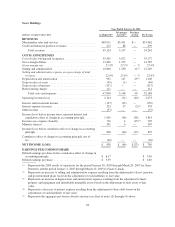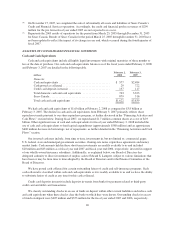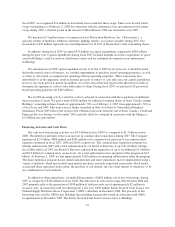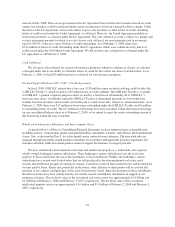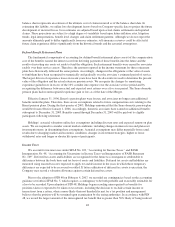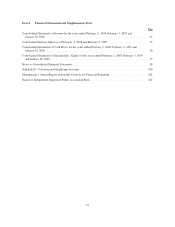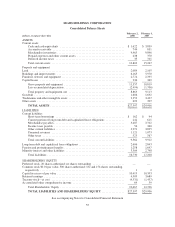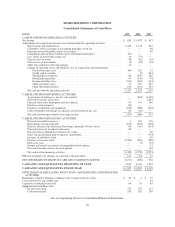Sears 2007 Annual Report Download - page 48
Download and view the complete annual report
Please find page 48 of the 2007 Sears annual report below. You can navigate through the pages in the report by either clicking on the pages listed below, or by using the keyword search tool below to find specific information within the annual report.balance sheets represents an estimate of the ultimate cost of claims incurred as of the balance sheet date. In
estimating this liability, we utilize loss development factors based on Company-specific data to project the future
development of incurred losses. Loss estimates are adjusted based upon actual claims settlements and reported
claims. These projections are subject to a high degree of variability based upon future inflation rates, litigation
trends, legal interpretations, benefit level changes and claim settlement patterns. Although we do not expect the
amounts ultimately paid to differ significantly from our estimates, self-insurance reserves could be affected if
future claim experience differs significantly from the historical trends and the actuarial assumptions.
Defined Benefit Retirement Plans
The fundamental components of accounting for defined benefit retirement plans consist of the compensation
cost of the benefits earned, the interest cost from deferring payment of those benefits into the future and the
results of investing any assets set aside to fund the obligation. Such retirement benefits were earned by associates
ratably over their service careers. Therefore, the amounts reported in the income statement for these retirement
plans have historically followed the same pattern. Accordingly, changes in the obligations or the value of assets
to fund them have been recognized systematically and gradually over the associate’s estimated period of service.
The largest drivers of experience losses in recent years have been the discount rate used to determine the present
value of the obligation and the actual return on pension assets. We recognize the changes by amortizing
experience gains/losses in excess of the 10% corridor into expense over the associate service period and by
recognizing the difference between actual and expected asset returns over a five-year period. The Sears domestic
pension plans had no unrecognized experience gain or loss as of the date of the Merger.
Effective January 31, 1996, Kmart’s pension plans were frozen, and associates no longer earn additional
benefits under the plans. Therefore, there are no assumptions related to future compensation costs relating to the
Kmart pension plans. During the first quarter of 2005, Holdings announced that the Sears domestic pension plan
would be frozen effective January 1, 2006. Accordingly, domestic associates have earned no additional benefits
subsequent to December 31, 2005. Benefits earned through December 31, 2005 will be paid out to eligible
participants following retirement.
Holdings’ actuarial valuations utilize key assumptions including discount rates and expected returns on plan
assets. We are required to consider current market conditions, including changes in interest rates and plan asset
investment returns, in determining these assumptions. Actuarial assumptions may differ materially from actual
results due to changing market and economic conditions, changes in investment strategies, higher or lower
withdrawal rates and longer or shorter life spans of participants.
Income Taxes
We account for income taxes under SFAS No. 109, “Accounting for Income Taxes,” and FASB
Interpretation No. 48, “Accounting for Uncertainty in Income Taxes–an Interpretation of FASB Statement
No. 109”. Deferred tax assets and liabilities are recognized for the future tax consequences attributable to
differences between the book basis and tax basis of assets and liabilities. Deferred tax assets and liabilities are
measured using enacted tax rates expected to apply to taxable income in the years in which those temporary
differences are expected to be recovered or settled. If future utilization of deferred tax assets is uncertain, the
Company may record a valuation allowance against certain deferred tax assets.
Prior to the adoption of FIN 48 on February 4, 2007, we recorded tax contingencies based on the accounting
guidance set forth in SFAS No. 5, which requires a contingency to be both probable and reasonably estimable for
a loss to be recorded. Upon adoption of FIN 48, Holdings began recording unrecognized tax benefits for
positions taken or expected to be taken on tax returns, including the decision to exclude certain income or
transactions from a return, when a more-likely-than-not threshold is met for a tax position and management
believes that the position will be sustained upon examination by the taxing authorities. In accordance with FIN
48, we record the largest amount of the unrecognized tax benefit that is greater than 50% likely of being realized
48


